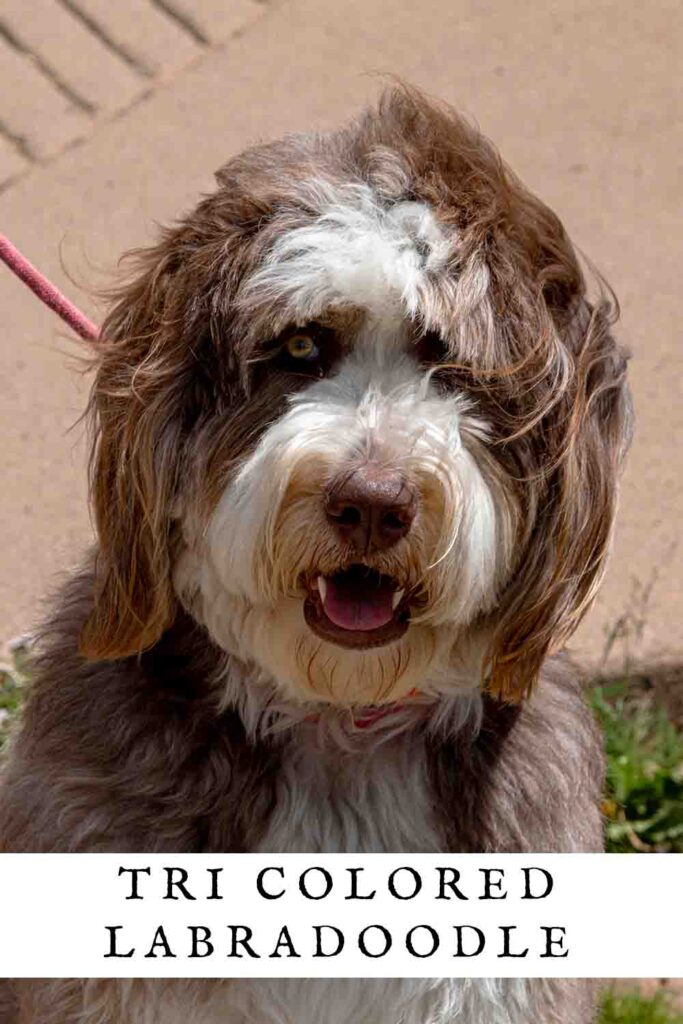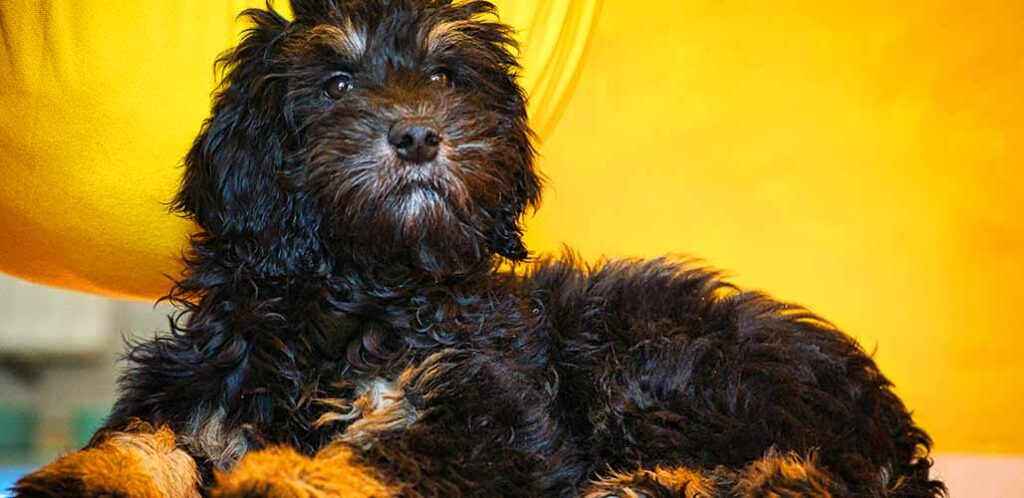A tri colored Labradoodle with black, white and tan in their coat is exceptionally rare in first generation crosses. Traditional tri colored patterns are produced by a specific combination of recessive genes, which is highly unlikely to occur in any dog that’s half Labrador. However, a multigeneration Labradoodle may eventually inherit a tricolor coat, and it is a recognized pattern for Australian Labradoodles too. There are also some other three colored coat patterns you might like to consider instead. So here’s everything you need to know about triple-hued Doodles.
Contents
- What is a tri colored Labradoodle?
- Is a tri color Labradoodle rare?
- Tri color Doodles as pets
- Other Labradoodles with eye-catching coats
What is a tri colored Labradoodle?
Tri color literally means ‘containing three colors’. But when it comes to our dogs’ coats, it traditionally has an even more specific meaning. Tri color dogs have coats that are black, tan and white. Beagles, Basset Hounds and Bernese Mountain Dogs are all famous for their tri colored coats. Let’s see how Labradoodles can inherit it too!
Tri color inheritance
Genetically, the tri color pattern has two parts:
- A black background with tan markings.
- And white patches on top.
Tan markings are a recessive trait. This means a puppy can only have them if both of their parents carry the tan markings gene and pass it on to them. The presence of the tan markings gene is well established in Poodles. Poodles with black and tan coats are also known as phantom colored. However, the tan markings gene is extremely unusual in Labradors. It is present in a very small number of individuals, probably as a result of crossing very early Labradors with Gordon Setters. But the odds of a Labrador carrying the tan markings gene being used in a first generation Labradoodle cross with a Poodle are pretty small.
The gene for white patches is also well established in Poodles, but vanishingly rare in Labradors. However this gene is incompletely dominant, rather than recessive. Which means a Labradoodle only needs to inherit one copy from their Poodle parent, and they’ll have some degree of white spotting in their fur.

Is a tri color Labradoodle rare?
What all this amounts to is that first generation Labradoodles from a Poodle x Labrador cross are extremely unlikely to have tricolor coats. This is because their Labrador parent probably doesn’t carry the necessary gene for tan markings. However, second, third, and multi generational Labradoodles, which have Poodles on both sides of their family tree, could be born with tricolor markings. The odds are relatively small if a sire and dam are picked at random. But they increase if the breeder specifically chooses parents with phantom, particolor, and tricolor Poodles in their family tree.
Tricolor is also a recognized coat for Australian Labradoodles. Australian Labradoodlesare multi generation Labradoodles which have been bred to meet their own specifically-developed breed standard. The aim is that they will one day be recognized as pedigree dogs in their own right. Genetic testing of Australian Labradoodles has revealed that after many generations of breeding they are significantly more closely related to Poodles than Labradors. Which also explains how tricolor coats have become so prevalent among them.
Tri colored Labradoodles as pets
Having a tri colored coat does not affect a Labradoodle’s health or temperament, or other coat properties like shedding level. Just like other second, third, and multigen Labradoodles, they are likely to be active, intelligent, and devoted to their human family. They will enjoy problem solving, respond well to training, and enjoy mental stimulation. They are popular pets for families because they are usually gentle with children and other pets.
But whether they will inherit a curly non-shedding coat or a straight shedding coat, and whether they will be socially confident like a Lab or more reserved like a Poodle, is impossible to predict. Even the parents’ coats and temperaments aren’t good predictors of what qualities their puppies will inherit. This is because it takes several generations to ‘shake out’ genetic traits that are being carried silently. So if you want a tri colored Labradoodle with a reliably non-shedding coat, it’s better to choose an Australian Labradoodle over a second or third generation cross.
Other Labradoodles with eye-catching coats
Black, white and tan is traditional, but it’s not the only way Labradoodles can have three colors in their coats. Some coats with three colors and lots of pattern going on are:
- merle particolor coats
- and merle phantom coats.
Merle particolor coats
There are two tri colored possibilities for merle particolor coats:
- Blue merle particolor, which is black, gray and white.
- Chocolate merle particolor, which is red, cream and white.
Merle coats have a pale background (gray or cream) with irregular spots, splashes and speckles of darker pigment (black or red). Particolor merle dogs also have white patches on their coat, providing a third color. Merle patterning has a controversial status is Labradoodles. Neither Poodles nor Labradors carry the merle gene, so it’s unheard of in first generation Labradoodles. But it pops up in Australian Labradoodles due to previous outcrossing with Cocker Spaniels. The breed standard disqualifies merle dogs from registration as recognized Australian Labradoodles. But it hasn’t put some breeders off producing them anyway.
Merle phantom coats
There are two tri colored Labradoodles with merle phantom coats too:
- Blue merle phantom, which is a grey and black merle background with tan markings.
- Chocolate merle phantom, which is a cream and red merle background with tan markings.
Or to put it another way: merle particolor is merle plus white, and merle phantom is merle plus tan. Breeders must take care breeding merle puppies, because if both parents carry the merle gene and pass it on to their offspring, the puppies have a high risk of sight and hearing loss. To avoid heart ache, both sire and dam should be tested for the merle gene before mating. Only one should be a carrier.
Tri colored Labradoodle – summary
A Labradoodle with traditional tricolor markings has a black, tan and white in their coat. This color combination relies on a puppy inheriting the recessive gene for tan markings from both parents. It is extremely unlikely in the case of first generation Labradoodles with a Labrador parent. Whilst it can be engineered in second and third generation litters, other traits like coat shedding level and temperament are less predictable. The most reliable way to get a tricolor Labradoodle with a temperament that matches their parents’ is to choose an Australian Labradoodle.
If you’re considering adding a tri colored Labradoodle to your home, we’d love to hear from you. Tell us all about them in the comments box down below!

